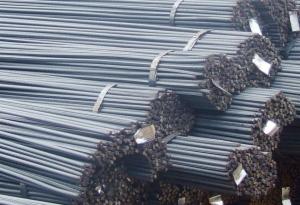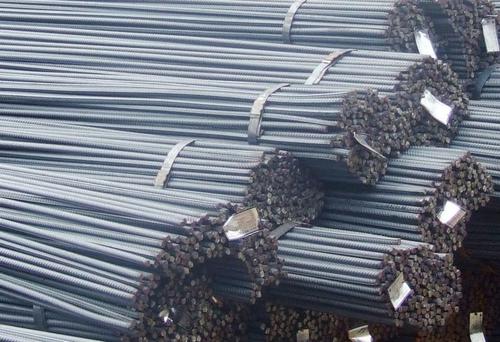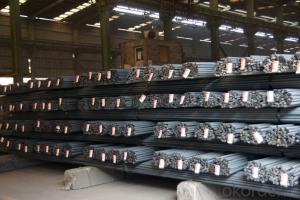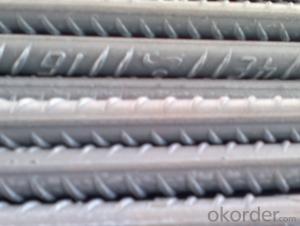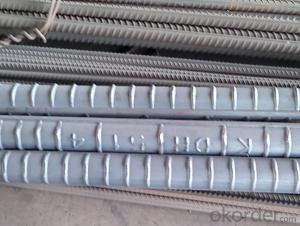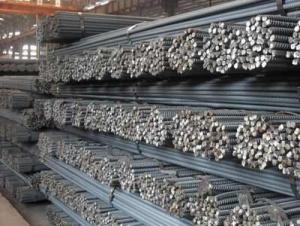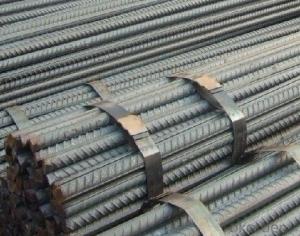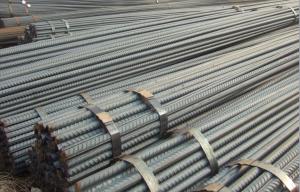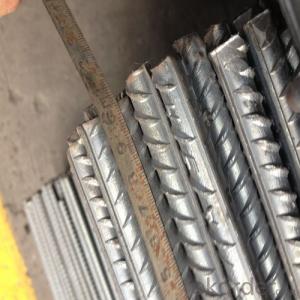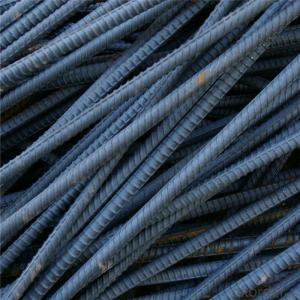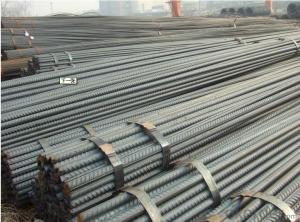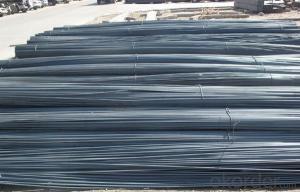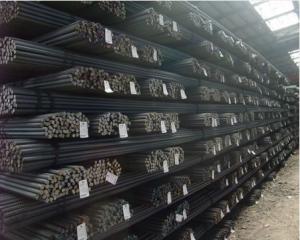Deformed Steel Bar ASTM A615 GR40 GR60 Or BS 4449
- Loading Port:
- China Main Port
- Payment Terms:
- TT or LC
- Min Order Qty:
- -
- Supply Capability:
- -
OKorder Service Pledge
OKorder Financial Service
You Might Also Like
Product Description:
OKorder is offering high quality Hot Rolled Steel I-Beams at great prices with worldwide shipping. Our supplier is a world-class manufacturer of steel, with our products utilized the world over. OKorder annually supplies products to European, North American and Asian markets. We provide quotations within 24 hours of receiving an inquiry and guarantee competitive prices.
Product Applications:
Deformed bar is widely used in buildings, bridges, roads and other engineering construction. Big to highways, railways, bridges, culverts, tunnels, public facilities such as flood control, dam, small to housing construction, beam, column, wall and the foundation of the plate, deformed bar is an integral structure material. With the development of world economy and the vigorous development of infrastructure construction, real estate, the demand for deformed bar will be larger and larger
Product Advantages:
OKorder's Steel I-Beams are durable, strong, and resist corrosion, exact size, regular package, chemical and mechanical properties are stable.
Main Product Features:
· Premium quality
· Prompt delivery & seaworthy packing (30 days after receiving deposit)
· Corrosion resistance
· Can be recycled and reused
· Mill test certification
· Professional Service
· Competitive pricing
Product Specifications:
Manufacture: Hot rolled
Grade: BS4449
Certificates: ISO, SGS, BV, CIQ
Diameter: 6mm,8mm,10mm,12mm,14mm,16mm,18mm,20mm,
22mm,25mm,28mm,32mm,36mm,40mm,50mm
Length: 6M, 9M,12M or as required
Packaging: Export packing, nude packing, bundled
Chemical Composition: (Please kindly find our chemistry of our material based on HRB500 as below for your information)
Grade | Technical data of the original chemical composition (%) | ||||||
C | Mn | Si | S | P | V | ||
HRB400 | ≤0.25 | ≤1.60 | ≤0.80 | ≤0.045 | ≤0.045 | 0.04-0.12 | |
Physical capability | |||||||
Yield Strength (N/cm²) | Tensile Strength (N/cm²) | Elongation (%) | |||||
≥400 | ≥570 | ≥14 | |||||
Theoretical weight and section area of each diameter as below for your information:
Diameter(mm) | Section area (mm²) | Mass(kg/m) | Weight of 12m bar(kg) |
6 | 28.27 | 0.222 | 2.664 |
8 | 50.27 | 0.395 | 4.74 |
10 | 78.54 | 0.617 | 7.404 |
12 | 113.1 | 0.888 | 10.656 |
14 | 153.9 | 1.21 | 14.52 |
16 | 201.1 | 1.58 | 18.96 |
18 | 254.5 | 2.00 | 24 |
20 | 314.2 | 2.47 | 29.64 |
22 | 380.1 | 2.98 | 35.76 |
25 | 490.9 | 3.85 | 46.2 |
28 | 615.8 | 4.83 | 57.96 |
32 | 804.2 | 6.31 | 75.72 |
36 | 1018 | 7.99 | 98.88 |
40 | 1257 | 9.87 | 118.44 |
50 | 1964 | 15.42 | 185.04 |
FAQ:
Q1: How soon can we receive the product after purchase?
A1: Within three days of placing an order, we will begin production. The specific shipping date is dependent upon international and government factors, but is typically 7 to 10 workdays.
Q2: What makes stainless steel stainless?
A2: Stainless steel must contain at least 10.5 % chromium. It is this element that reacts with the oxygen in the air to form a complex chrome-oxide surface layer that is invisible but strong enough to prevent further oxygen from "staining" (rusting) the surface. Higher levels of chromium and the addition of other alloying elements such as nickel and molybdenum enhance this surface layer and improve the corrosion resistance of the stainless material.
Q3: Can stainless steel rust?
A3: Stainless does not "rust" as you think of regular steel rusting with a red oxide on the surface that flakes off. If you see red rust it is probably due to some iron particles that have contaminated the surface of the stainless steel and it is these iron particles that are rusting. Look at the source of the rusting and see if you can remove it from the surface.

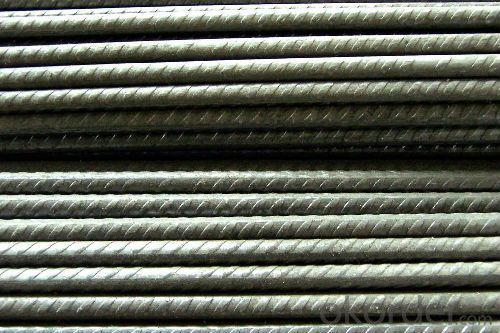
- Q: What is the national standard of thread steel No. 8?
- Steel is known as hot rolled ribbed bar. The rebar is a kind of small section steel, mainly used for the skeleton of reinforced concrete construction members. In use, some mechanical strength, bending deformation property and welding performance are required.
- Q: Are there any restrictions on the use of steel rebars in certain regions?
- Certain regions have restrictions on the use of steel rebars. These restrictions can differ from one region to another and are implemented to guarantee the safety and stability of structures. In specific locations, building codes and regulations may dictate particular criteria for the use of steel rebars, including their type, size, and placement. Additionally, there may be limitations on the utilization of certain types of steel rebars, such as epoxy-coated rebars, owing to environmental considerations. Construction professionals should acquaint themselves with the local building codes and regulations to ensure adherence and enhance the safety and longevity of structures.
- Q: Difference between round bar and threaded steel in use
- The rebar is much higher than the ordinary, and the low carbon steel rounds are much higher. The heat treated steel is much stronger than the low carbon round steel, nearly twice or even higher.
- Q: How do steel rebars affect the overall durability of concrete?
- Steel rebars have a significant impact on the overall durability of concrete structures. The presence of steel rebars in concrete enhances its strength and resistance to various external forces and environmental conditions. One of the primary functions of steel rebars is to provide tensile strength to concrete, which is otherwise weak in resisting tension. Concrete is excellent in compression but tends to crack under tension. By embedding steel rebars within the concrete, these cracks are effectively controlled and prevented from expanding, thus improving the durability of the structure. Steel rebars also help in increasing the flexural strength of concrete, making it more capable of withstanding bending and deformations. This is particularly crucial in structures such as beams, columns, and slabs that experience significant loads and forces during their lifespan. Moreover, steel rebars act as a reinforcement in concrete, improving its resistance to external factors such as earthquakes, wind, and impact loads. The presence of rebars helps in distributing and dissipating these forces throughout the structure, reducing the chances of structural failure and increasing the overall durability. Another critical aspect is the prevention of corrosion in reinforced concrete structures. The steel rebars are typically coated with materials that protect them from corrosion caused by moisture and chemical reactions. This protective coating, coupled with the alkaline environment of concrete, creates a barrier that significantly slows down the corrosion process, thereby increasing the longevity and durability of the concrete structure. In conclusion, steel rebars play a vital role in enhancing the overall durability of concrete structures. They provide the necessary tensile strength, improve flexural strength, enhance resistance to external forces, and prevent corrosion. By incorporating steel rebars, concrete becomes more robust, long-lasting, and capable of withstanding various challenges, ensuring the longevity and safety of the structure.
- Q: What are the precautions to be taken while welding steel rebars?
- When welding steel rebars, there are several precautions that need to be taken to ensure safe and effective welding: 1. Proper ventilation: Welding generates fumes and gases that can be harmful if inhaled. Therefore, it is important to work in a well-ventilated area or use exhaust systems to remove the fumes and maintain a safe breathing environment. 2. Personal protective equipment (PPE): Welders should always wear appropriate PPE, including a welding helmet or face shield, safety glasses, welding gloves, flame-resistant clothing, and steel-toed boots. This protective gear helps minimize the risk of burns, eye injuries, and other physical hazards. 3. Fire prevention: Welding involves intense heat and sparks, which can ignite flammable materials. Before starting the welding process, ensure that the work area is clear of any combustible materials, and have a fire extinguisher nearby. It is also advisable to have a fire watch person present to monitor the area for any potential fire hazards. 4. Grounding: Proper grounding is essential to prevent electrical shocks during welding. Ensure that the welding machine is properly grounded, and the workpiece is connected to a reliable grounding point. 5. Preparing the surface: Before welding, the surfaces of the rebars should be clean and free from any oils, grease, dirt, or rust. Use a wire brush or grinder to remove any contaminants, as they can affect the quality of the weld. 6. Welding technique: Employing the correct welding technique is crucial for achieving strong and reliable welds. Follow the recommended welding parameters, such as the appropriate current, voltage, and electrode diameter, to ensure optimal results. It is also important to maintain a steady hand and a consistent travel speed to prevent weld defects. 7. Training and experience: Welding steel rebars requires skill and knowledge. Ensure that the welder is properly trained and experienced in working with rebars. This will help minimize errors and ensure that the welds meet the required standards and specifications. By adhering to these precautions, welders can significantly reduce the risk of accidents, injuries, and subpar weld quality when working with steel rebars.
- Q: How are steel rebars measured?
- Steel rebars are measured using a standardized system known as the "bar size number." This system assigns a numerical value to each rebar size, which corresponds to the diameter of the rebar. The diameter is measured in inches or millimeters, depending on the region or country. In the United States, the bar size number is used, which ranges from #3 to #18. The number indicates the diameter of the rebar in eighths of an inch. For instance, a #3 rebar has a diameter of 3/8 inch, while a #8 rebar has a diameter of 1 inch. Beyond #8, the diameter is measured in quarters of an inch. For example, a #11 rebar has a diameter of 1 1/8 inches, and a #18 rebar has a diameter of 2 1/4 inches. In metric countries, rebars are measured using millimeters. The diameter is typically rounded to the nearest millimeter. For instance, a 10 mm rebar is equivalent to a #3 rebar in the US, and a 25 mm rebar is equivalent to a #8 rebar. To measure the length of a rebar, a tape measure or ruler is used. The length is typically measured in feet or meters. Rebars are commonly available in lengths of 20 or 40 feet (6 or 12 meters), but they can also be cut to custom lengths as per project requirements. It is important to note that the measurement system may vary slightly in different regions or countries, so it is crucial to consult local standards and codes for accurate measurement guidelines.
- Q: Can steel rebars be used in structures with high resistance to creep?
- Yes, steel rebars can be used in structures with high resistance to creep. Steel rebars are commonly used in reinforced concrete structures and provide strength and durability to the overall structure. Creep is the gradual deformation of a material under constant stress over time. While steel does exhibit some creep, it is considered to have a low creep rate compared to other materials such as concrete or timber. Additionally, the use of rebars in reinforced concrete structures can help distribute the load and minimize the effects of creep by adding stiffness and reducing the overall stress on the concrete. Therefore, steel rebars can be effectively used in structures with high resistance to creep when designed and installed properly.
- Q: What is the role of steel rebars in basement wall construction?
- Steel rebars play a crucial role in basement wall construction by providing reinforcement and structural support to the concrete wall. Reinforcing bars, which are commonly made of carbon steel, are strategically positioned within the concrete prior to pouring. Their placement adds strength and stability to the wall, allowing it to withstand various external forces such as soil pressure and lateral forces. By distributing the load and forces that the wall may encounter, steel rebars prevent cracking or collapse under these pressures, ensuring the wall's durability and structural integrity. Additionally, they help control shrinkage and expansion of the concrete caused by temperature changes. By acting as a framework within the wall, the rebars limit the formation of cracks and maintain the overall stability of the structure. In summary, the inclusion of steel rebars significantly enhances the strength and durability of basement walls. They are essential for maintaining the integrity of the structure and safeguarding it against potential damage or failure.
- Q: How do steel rebars improve the load-carrying capacity of concrete?
- The load-carrying capacity of concrete is enhanced by steel rebars, which strengthen and reinforce the material. By embedding steel rebars within the concrete, tensile strength is provided to an otherwise tension-weak material. Concrete is known for its strength in compression but lacks strength in tension. The steel rebars serve as a support system within the concrete, ensuring a more even distribution of the load and preventing the occurrence of cracks or failure. When a load is applied, the rebars resist the tensile forces and contribute to holding the concrete together, thereby improving its load-carrying and distribution capabilities. Moreover, steel rebars also enhance the ductility of concrete. Ductility refers to the capacity of a material to deform without fracturing. The inclusion of steel rebars in the concrete increases its flexibility and ability to withstand higher levels of stress and strain without experiencing failure. This is particularly valuable in structures that may face earthquakes, as their ability to absorb and dissipate energy is crucial for maintaining overall integrity. In conclusion, steel rebars bolster the load-carrying capacity of concrete by providing tensile strength, promoting even load distribution, preventing cracks, and enhancing overall ductility. This reinforcement and strength enhancement greatly enhance the stability and durability of concrete structures.
- Q: What are the guidelines for the proper anchoring of steel rebars in walls?
- The proper anchoring of steel rebars in walls is crucial to ensure the structural integrity and stability of the construction. Here are some guidelines to follow for the correct anchoring of steel rebars in walls: 1. Determine the required rebar size and spacing: The size and spacing of rebars depend on the design specifications and load requirements. Consult the structural engineer or refer to the building codes for the appropriate rebar size and spacing. 2. Clean and prepare the concrete surfaces: Before anchoring the rebars, ensure that the concrete surfaces are clean, free from dust, debris, and any loose material. Use a wire brush or compressed air to remove any contaminants. 3. Use proper anchoring techniques: The most common method for anchoring steel rebars in walls is by embedding them into the concrete. Ensure that the rebars are securely embedded by following these steps: a. Drill holes: Drill holes in the concrete wall at the specified locations and depths, ensuring that the diameter of the hole matches the rebar size. b. Clean the drilled holes: Remove any dust or debris from the drilled holes using compressed air or a brush. c. Insert rebars: Insert the rebars into the drilled holes, making sure they reach the required embedment depth. d. Proper spacing: Maintain the specified spacing between rebars based on the design requirements. e. Secure rebars: Use appropriate anchoring materials like epoxy resin or grout to secure the rebars in place. Follow the manufacturer's instructions for mixing and applying the anchoring material. f. Ensure proper alignment: Verify that the rebars are correctly aligned, both horizontally and vertically, before the anchoring material sets. 4. Allow sufficient curing time: After anchoring the rebars, allow sufficient time for the anchoring material to cure. This ensures that the rebars are firmly secured in place. 5. Properly protect the rebars: Once the rebars are anchored, protect them from corrosion by applying a suitable corrosion-resistant coating or using corrosion-resistant rebars. It is essential to follow these guidelines, as improper anchoring of steel rebars can compromise the structural integrity of the walls and pose safety risks. Always consult with a qualified structural engineer or building professional for specific guidelines tailored to your project.
Send your message to us
Deformed Steel Bar ASTM A615 GR40 GR60 Or BS 4449
- Loading Port:
- China Main Port
- Payment Terms:
- TT or LC
- Min Order Qty:
- -
- Supply Capability:
- -
OKorder Service Pledge
OKorder Financial Service
Similar products
Hot products
Hot Searches
Related keywords
